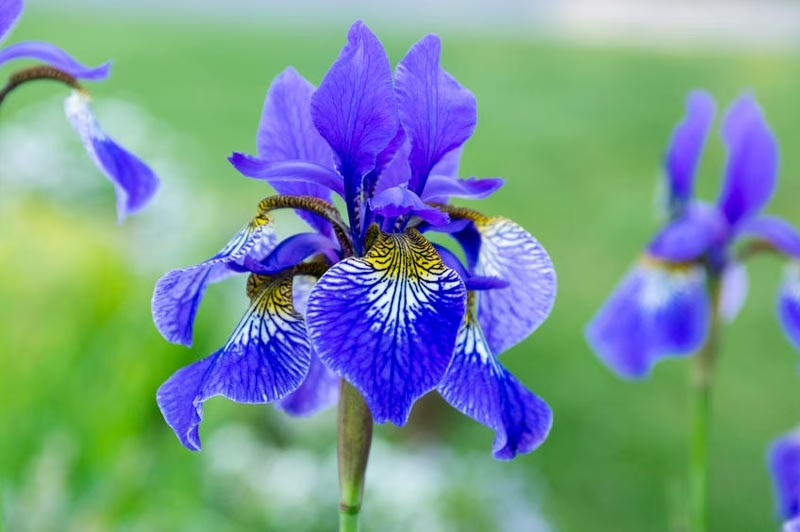
Iris
Botanical Name
:
Iris spp.
Plant Type
:
Flowering perennial
Seasons
:
Plant in late summer to early fall; Blooms in spring and summer
Sun Level
:
Full sun with at least 6 hours of sunlight daily
Ideal Soil Temperature for Planting
:
60–75°F (15–24°C)
Soil Type
:
Well-draining, fertile soil
Hardiness Zones
:
Slightly acidic to neutral
Germination
:
Takes 2–3 weeks
P.H. Level
:
3–9 (USDA)
Water/Irrigation
:
Water only when the soil is dry 2–3 inches deep
Fertilization
:
Use a low-nitrogen fertilizer such as 5-10-5, 5-10-10, or 6-24-24 in fall; Fertilize around the plant, avoiding direct contact with the rhizome
Habit
:
Clumping from rhizomes or bulbs
Propagation
:
Division
Final Plant Height
:
2–4 ft (60–120 cm)
Spread
:
2–3 ft (60–90 cm)
Flowers
:
Blue, orange, pink, purple, red, white, gold, yellow, and multicolor
Attracts
:
Butterflies, hummingbirds
Uses
:
Lovely cut flowers
Companions
:
Roses, peonies, and lilies
Pruning
:
Remove winter mulch and old foliage; Deadhead spent blooms consistently; Trim flower stems back to the base to prevent rhizome rot
Toxicity
:
Mild toxicity in humans but can be serious in animals; roots are especially toxic
Pests
:
Aphids, iris borers, nematodes, slugs, snails, thrips
Diseases
:
Rhizome rot, basal rot, iris severe mosaic (gray disease), and leaf spots
Fun Fact
:
The name “Iris” comes from the Greek word iris, meaning “rainbow,” referencing the variety of colors in iris flowers. In Greek mythology, Iris was the goddess of the rainbow, further connecting the flower’s name to its colorful blooms.
Additional Info
:
Mulching around the rhizomes helps retain moisture and adds nutrients to the soil, but avoid covering the iris rhizome with mulch, as it can lead to rot
Botanical Name
:
Iris spp.
Plant Type
:
Flowering perennial
Seasons
:
Plant in late summer to early fall; Blooms in spring and summer
Sun Level
:
Full sun with at least 6 hours of sunlight daily
Ideal Soil Temperature for Planting
:
60–75°F (15–24°C)
Soil Type
:
Well-draining, fertile soil
Hardiness Zones
:
Slightly acidic to neutral
Germination
:
Takes 2–3 weeks
P.H. Level
:
3–9 (USDA)
Water/Irrigation
:
Water only when the soil is dry 2–3 inches deep
Fertilization
:
Use a low-nitrogen fertilizer such as 5-10-5, 5-10-10, or 6-24-24 in fall; Fertilize around the plant, avoiding direct contact with the rhizome
Habit
:
Clumping from rhizomes or bulbs
Propagation
:
Division
Final Plant Height
:
2–4 ft (60–120 cm)
Spread
:
2–3 ft (60–90 cm)
Flowers
:
Blue, orange, pink, purple, red, white, gold, yellow, and multicolor
Attracts
:
Butterflies, hummingbirds
Uses
:
Lovely cut flowers
Companions
:
Roses, peonies, and lilies
Pruning
:
Remove winter mulch and old foliage; Deadhead spent blooms consistently; Trim flower stems back to the base to prevent rhizome rot
Toxicity
:
Mild toxicity in humans but can be serious in animals; roots are especially toxic
Pests
:
Aphids, iris borers, nematodes, slugs, snails, thrips
Diseases
:
Rhizome rot, basal rot, iris severe mosaic (gray disease), and leaf spots
Fun Fact
:
The name “Iris” comes from the Greek word iris, meaning “rainbow,” referencing the variety of colors in iris flowers. In Greek mythology, Iris was the goddess of the rainbow, further connecting the flower’s name to its colorful blooms.
Additional Info
:
Mulching around the rhizomes helps retain moisture and adds nutrients to the soil, but avoid covering the iris rhizome with mulch, as it can lead to rot
Written by Nondiah Khalayi – https://www.linkedin.com/in/nondiah-khalayi/

